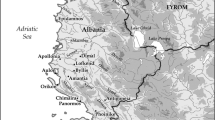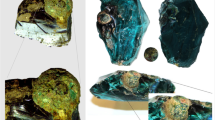Abstract.
Monochrome coloured glass beads of the Merovingians (5th–7th cent. AD) have been examined by different analytical methods. The elemental composition of a large number of mostly unprepared beads have been measured non-destructively by X-ray fluorescence analysis. After subtracting the content of the colouring oxides of the glass beads and normalising the residual values to 100% an identical soda-lime-glass matrix was obtained. X-ray diffraction was used for the identification of the crystalline colouring and opacifying pigments (SnO2, Cu, Cu2O, PbSnO3), and scanning electron microscopy as well as electron probe microanalysis were applied to study the microstructure and the composition of white, brown, green, orange and yellow coloured glass beads. Oxidised metals, alloys (lead, copper, bronze, brass and mixtures of them) and iron smelting slag have been identified as raw materials to colour the soda-lime-glass.
Similar content being viewed by others
Author information
Authors and Affiliations
Rights and permissions
About this article
Cite this article
Heck, M., Hoffmann, P. Analysis of Early Medieval Glass Beads – The Raw Materials to Produce Green, Orange and Brown Colours. Mikrochim Acta 139, 71–76 (2002). https://doi.org/10.1007/s006040200042
Issue Date:
DOI: https://doi.org/10.1007/s006040200042




